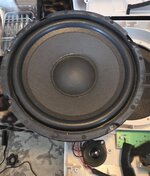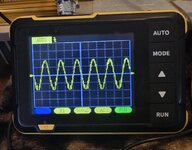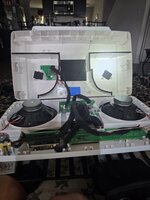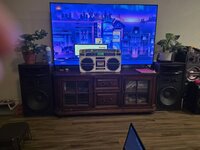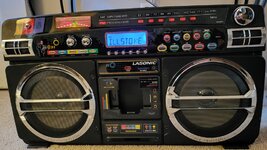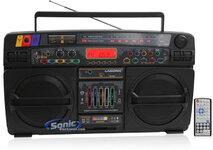The "new" Lasonic i931BT:
Sold by Lasonic Lifestyles Inc:
These "new" units come with a small credit-card sized remote with bubble buttons and a charging cord. This remote does work, but range is limited to a few feet. However, the internal CR-2025 battery could be old as well (?). N0 POWER CORD. The charging cord is a simple 5 VDC charger with a USB-A at one end and a barrel 5.5-mm plug at the other. This cord will NOT POWER the unit when playing. It is intended only to recharge the internal battery when NOT IN USE. NO MANUAL included. NO WEBSITE TO DOWNLOAD A MANUAL. I emailed Lasonic a month ago. NO RESPONSE. My expectations are low.
Warranty? Who knows? No paperwork inferring any warranty. No contact information. I had to surf the internet to find the above contact info, fyi.
The Weird:
No UL LISTING on the rear of the set. No such listing anywhere. I don't understand how Lasonic is skirting the law requiring this info.
Rear switch function? The original Lasonic was AC/DC. The switch allowed user choice. No AC on this unit. However, the switch has an unintended function. Switched left, it allows battery power or external battery power. Switched right, it disconnects all power. Therefore, this switch can actually function as a main on/off. Good for instances where the unit may be stored or unused for long periods of time.
Five preset tonal adjustments. One is marked "LOUDNESS". However, that it is now 'FLAT" (no tonal adjustment applied).
Menu button indicates Bass/Treble is available. Wrong! No bass/treble. Only clock (24 hour only), alarm and an "off" timer which can be used as a kind of sleep timer or sorts.
The 5-band Equalizer is wired BACKWARDS! No joke. Every unit I tried was the same. The 10 Khz band controls the bass, and vice-versa. What?????
Only 4 bands work, even though all five bands light up red. The highest band, "10 Khz" does not work at all. This was also the case on every unit I tried.
Remote Control:
Some buttons are straight forward. Others are not. The following is my best guess.
MICKTV button: refers to microphone in conjunction with karaoke tv. I don't have a wired mic to test this function. May switch mic on/off?
ECO button: may refer to echo mode when using microphone with karaoke.
MICVOL: may allow adjustment of connected mic volume?
SOUND: allows selection of the 5 different preset tonal choices.
TIME: I do not see any activity when pressing. I assume it is related to the alarm or sleep timers?
THE "5-BAND EQ" (wired backwards)
The highest band does NOT FUNCTION. I do not know why? But there seems to be a boost of anywhere from +6 dB to +9 dB, depending on whether you are listening via the main speakers and the level of volume, or with headphones.
The high band is claimed to be "10 Khz. I measured a center-frequency of 8 Khz, which is NOT ADJUSTABLE.
The next band is claimed to be 3.3 Khz (mid-high band). I measured a center of 4-5 Khz. The +/- 10 dB is accurate.
The mid-band is supposed to be 1 Khz. I measured a center of 2 Khz. The +/- 10 dB is accurate.
The upper-bass band is supposed to be 330 Hz. I measured a center of 263 Hz. The +/- 10 dB is accurate.
The bass band is supposed to be 100 Hz. I measured a center of 35 Hz !!!!!!! +/- 10 dB is accurate. VERY NICE! Much more useful than the standard useless 100 Hz mid-bass which I never liked, going all the way back to the 70's and 80's. KUDOS to Lasonic !
This model employs a Fangtec ft3128 D-class amplifier chip. NO HEAT SINK.
The internal battery measured at 12.2 VDC output. It is pretty hefty. I suspect it can deliver 3-5 AH (?).
AMPLIFIER AUTOMATIC LEVEL CONTROL BUILT-IN:
Amplifier THD is high at any level, even below 1 watt. I don't know why? Also, this chip incorporates ALC, which I abhor. I never liked ALC circuitry, going all the way back to the tape decks of the 80's. ALC never works.
So I disabled the ALC on this unit. I disconnected PIN #13 ON THE FANGTEC CHIP, per the Fangtec data sheet.
Before disconnecting, I had to push 775 mV input (AUX) to approach clipping.
After disabling ALC, I now need only 200 mV to achieve full output before clipping. Output power before/after clipping remained the same.
Before disconnecting, the sound would go in-and-out at higher volume levels or when heavy bass content was played.
After disabling ALC, sound can go into distortion, but the annoying fading in-and-out is almost completely gone. If the unit fades at all, I suspect it is due to excessive power supply demands and not the fault of the amp.
THD high either with ALC activated or not. My measurements are after disabling ALC:
POWER OUTPUT: 10.5 Watts + 10.5 Watts, into 4 ohms, 1 Khz, less than 6.5% THD. I don't know why THD is high?
POWER BANDWIDTH AT RATED OUTPUT: 20 Hz to 20 Khz, less than -3 dB. That's very good for a boombox or mini amp.
D-class amps, especially cheap ones, emit high-speed switching noise which may or may not be audible, but will show up on an oscilloscope as a type of distortion of the sine wave. I will attach pics of oscilloscope before and after adding a low-pass filter, designed to filter out that noise. The Fangtec data sheet recommends a 33 uH coil. However, I chose a 22 uH coil, which should begin filtering around 29 Khz, well above our 20 Khz audible limit. I did so to make certain all audible frequencies come through unaffected. I used a very small inexpensive toroidal-type coil, measuring less than 1/2 inch in diameter. The sine wave is now very clean (see attached pics)
S/N RATIO:
Very good. I measured 97 dB or better. That is High Fidelity level.
DAMPING FACTOR:
For the heck of it, I measured. My main audio system consists of a Yamaha receiver which boasts a DF of 120 or more, across the entire bandwidth. I am limited due to my simple test equipment. So, I measured at 50 Hz, the accepted standard bass test frequency.
My Yamaha receiver measured 124. Therefore, I deem my test to be in-the-ballpark.
The Lasonic measured 21.
There is much discussion on this spec's value. Back in the 80's and 90's, many reputable manufacturers touted their amps "feedback circuitry" and how it improved sonic performance.
According to general consensus, 50 to 100 is good. Above 100 is better. Approaching 150 is excellent. Above 150 is moot, as we cannot discern any further improvement (?).
However, some claim a value above 10 or 15 is sufficient.
I tried measuring CROSSTALK. The standard for High Fidelity is 70/50 (1 Khz/10 Khz), or more.
My Yamaha receiver is specified as 70/50. But I only measured 56/43, which is subpar.
I measured 55/36 on the Lasonic.
However, my equipment may be at fault. I do not believe I am establishing an accurate low-signal measurement when comparing high-signal to low-signal on this test. For purposes of this test, the Lasonic performed pretty close to my main audio receiver, which is good enough for me.
The SPEAKERS:
According to the retail box, the included speakers are "CEWIN VEGA". As one reviewer joked, "is this supposed to be Cerwin Vega?". Who knows? The transducers are unmarked.
The tweeter is a standard 1-1/2 inch paper cone. Paper cones are fine. To this day, an inexpensive cone tweeter can sound as natural as many much more expensive hybrid tweeter designs. The size of this tweeter is in keeping with the tweeters of the past great boomboxes.
The tweeter uses a simple 4.7 uf capacitor for a nominal crossover of about 8 Khz.
The woofer is a true 8 inch. This is the only retro boombox with woofers the size of the 80's greats, such as those found in the JVCs, the CROWNs, or the CONIONs. No crossover, which is fine for woofers, depending on their roll-off characteristics.
For anyone who works with transducers, these are obviously inexpensive low-end woofers. However, compared to woofers in one-piece retro sytled boomboxes, these woofers are excellent! It is a matter of perspective.
These woofers feature a heavy paper cone. A decent magnet of about 8-10 ounces. A 1 inch voice coil. And a wide foam-rolled cone suspension which allows decent movement (X-MAX probably around 1.5 to 2.5 mm, I imagine)
I measured the woofer"s free-air resonance (Fs) to be 53 Hz, which is very good. Typical 8 inch woofers will have a Fs in the 40's to 50's Hz range, with some extending lower.
speaker impedance is measured at 4 ohms.
Sold by Lasonic Lifestyles Inc:
LASONIC i931BTQ
(revised model)
[manufacture date: released 2022 (?)]
Lasonic Lifestyle Incorporated
3761 S. Hill Street
LA, CA 90007
213-668-6696
cs@lasoniclifestyle.com
* Not the original Lasonic brand, fyi. (revised model)
[manufacture date: released 2022 (?)]
Lasonic Lifestyle Incorporated
3761 S. Hill Street
LA, CA 90007
213-668-6696
cs@lasoniclifestyle.com
These "new" units come with a small credit-card sized remote with bubble buttons and a charging cord. This remote does work, but range is limited to a few feet. However, the internal CR-2025 battery could be old as well (?). N0 POWER CORD. The charging cord is a simple 5 VDC charger with a USB-A at one end and a barrel 5.5-mm plug at the other. This cord will NOT POWER the unit when playing. It is intended only to recharge the internal battery when NOT IN USE. NO MANUAL included. NO WEBSITE TO DOWNLOAD A MANUAL. I emailed Lasonic a month ago. NO RESPONSE. My expectations are low.
Warranty? Who knows? No paperwork inferring any warranty. No contact information. I had to surf the internet to find the above contact info, fyi.
The Weird:
No UL LISTING on the rear of the set. No such listing anywhere. I don't understand how Lasonic is skirting the law requiring this info.
Rear switch function? The original Lasonic was AC/DC. The switch allowed user choice. No AC on this unit. However, the switch has an unintended function. Switched left, it allows battery power or external battery power. Switched right, it disconnects all power. Therefore, this switch can actually function as a main on/off. Good for instances where the unit may be stored or unused for long periods of time.
Five preset tonal adjustments. One is marked "LOUDNESS". However, that it is now 'FLAT" (no tonal adjustment applied).
Menu button indicates Bass/Treble is available. Wrong! No bass/treble. Only clock (24 hour only), alarm and an "off" timer which can be used as a kind of sleep timer or sorts.
The 5-band Equalizer is wired BACKWARDS! No joke. Every unit I tried was the same. The 10 Khz band controls the bass, and vice-versa. What?????
Only 4 bands work, even though all five bands light up red. The highest band, "10 Khz" does not work at all. This was also the case on every unit I tried.
Remote Control:
Some buttons are straight forward. Others are not. The following is my best guess.
MICKTV button: refers to microphone in conjunction with karaoke tv. I don't have a wired mic to test this function. May switch mic on/off?
ECO button: may refer to echo mode when using microphone with karaoke.
MICVOL: may allow adjustment of connected mic volume?
SOUND: allows selection of the 5 different preset tonal choices.
TIME: I do not see any activity when pressing. I assume it is related to the alarm or sleep timers?
THE "5-BAND EQ" (wired backwards)
The highest band does NOT FUNCTION. I do not know why? But there seems to be a boost of anywhere from +6 dB to +9 dB, depending on whether you are listening via the main speakers and the level of volume, or with headphones.
The high band is claimed to be "10 Khz. I measured a center-frequency of 8 Khz, which is NOT ADJUSTABLE.
The next band is claimed to be 3.3 Khz (mid-high band). I measured a center of 4-5 Khz. The +/- 10 dB is accurate.
The mid-band is supposed to be 1 Khz. I measured a center of 2 Khz. The +/- 10 dB is accurate.
The upper-bass band is supposed to be 330 Hz. I measured a center of 263 Hz. The +/- 10 dB is accurate.
The bass band is supposed to be 100 Hz. I measured a center of 35 Hz !!!!!!! +/- 10 dB is accurate. VERY NICE! Much more useful than the standard useless 100 Hz mid-bass which I never liked, going all the way back to the 70's and 80's. KUDOS to Lasonic !
This model employs a Fangtec ft3128 D-class amplifier chip. NO HEAT SINK.
The internal battery measured at 12.2 VDC output. It is pretty hefty. I suspect it can deliver 3-5 AH (?).
AMPLIFIER AUTOMATIC LEVEL CONTROL BUILT-IN:
Amplifier THD is high at any level, even below 1 watt. I don't know why? Also, this chip incorporates ALC, which I abhor. I never liked ALC circuitry, going all the way back to the tape decks of the 80's. ALC never works.
So I disabled the ALC on this unit. I disconnected PIN #13 ON THE FANGTEC CHIP, per the Fangtec data sheet.
Before disconnecting, I had to push 775 mV input (AUX) to approach clipping.
After disabling ALC, I now need only 200 mV to achieve full output before clipping. Output power before/after clipping remained the same.
Before disconnecting, the sound would go in-and-out at higher volume levels or when heavy bass content was played.
After disabling ALC, sound can go into distortion, but the annoying fading in-and-out is almost completely gone. If the unit fades at all, I suspect it is due to excessive power supply demands and not the fault of the amp.
THD high either with ALC activated or not. My measurements are after disabling ALC:
POWER OUTPUT: 10.5 Watts + 10.5 Watts, into 4 ohms, 1 Khz, less than 6.5% THD. I don't know why THD is high?
POWER BANDWIDTH AT RATED OUTPUT: 20 Hz to 20 Khz, less than -3 dB. That's very good for a boombox or mini amp.
D-class amps, especially cheap ones, emit high-speed switching noise which may or may not be audible, but will show up on an oscilloscope as a type of distortion of the sine wave. I will attach pics of oscilloscope before and after adding a low-pass filter, designed to filter out that noise. The Fangtec data sheet recommends a 33 uH coil. However, I chose a 22 uH coil, which should begin filtering around 29 Khz, well above our 20 Khz audible limit. I did so to make certain all audible frequencies come through unaffected. I used a very small inexpensive toroidal-type coil, measuring less than 1/2 inch in diameter. The sine wave is now very clean (see attached pics)
S/N RATIO:
Very good. I measured 97 dB or better. That is High Fidelity level.
DAMPING FACTOR:
For the heck of it, I measured. My main audio system consists of a Yamaha receiver which boasts a DF of 120 or more, across the entire bandwidth. I am limited due to my simple test equipment. So, I measured at 50 Hz, the accepted standard bass test frequency.
My Yamaha receiver measured 124. Therefore, I deem my test to be in-the-ballpark.
The Lasonic measured 21.
There is much discussion on this spec's value. Back in the 80's and 90's, many reputable manufacturers touted their amps "feedback circuitry" and how it improved sonic performance.
According to general consensus, 50 to 100 is good. Above 100 is better. Approaching 150 is excellent. Above 150 is moot, as we cannot discern any further improvement (?).
However, some claim a value above 10 or 15 is sufficient.
I tried measuring CROSSTALK. The standard for High Fidelity is 70/50 (1 Khz/10 Khz), or more.
My Yamaha receiver is specified as 70/50. But I only measured 56/43, which is subpar.
I measured 55/36 on the Lasonic.
However, my equipment may be at fault. I do not believe I am establishing an accurate low-signal measurement when comparing high-signal to low-signal on this test. For purposes of this test, the Lasonic performed pretty close to my main audio receiver, which is good enough for me.
The SPEAKERS:
According to the retail box, the included speakers are "CEWIN VEGA". As one reviewer joked, "is this supposed to be Cerwin Vega?". Who knows? The transducers are unmarked.
The tweeter is a standard 1-1/2 inch paper cone. Paper cones are fine. To this day, an inexpensive cone tweeter can sound as natural as many much more expensive hybrid tweeter designs. The size of this tweeter is in keeping with the tweeters of the past great boomboxes.
The tweeter uses a simple 4.7 uf capacitor for a nominal crossover of about 8 Khz.
The woofer is a true 8 inch. This is the only retro boombox with woofers the size of the 80's greats, such as those found in the JVCs, the CROWNs, or the CONIONs. No crossover, which is fine for woofers, depending on their roll-off characteristics.
For anyone who works with transducers, these are obviously inexpensive low-end woofers. However, compared to woofers in one-piece retro sytled boomboxes, these woofers are excellent! It is a matter of perspective.
These woofers feature a heavy paper cone. A decent magnet of about 8-10 ounces. A 1 inch voice coil. And a wide foam-rolled cone suspension which allows decent movement (X-MAX probably around 1.5 to 2.5 mm, I imagine)
I measured the woofer"s free-air resonance (Fs) to be 53 Hz, which is very good. Typical 8 inch woofers will have a Fs in the 40's to 50's Hz range, with some extending lower.
speaker impedance is measured at 4 ohms.


